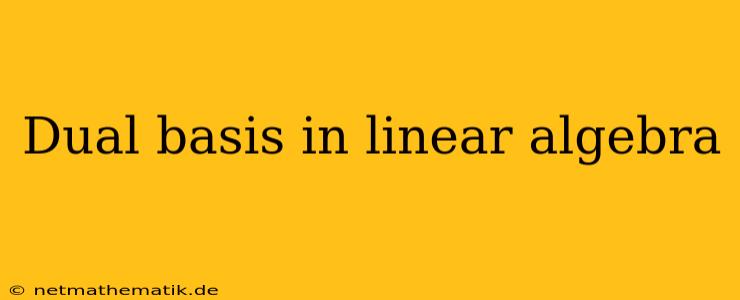The concept of a dual basis is a fundamental tool in linear algebra, providing a powerful framework for understanding and manipulating vector spaces. It enables us to connect a vector space with its dual space, a space of linear functionals acting on the original space. This connection offers valuable insights into the structure of linear transformations, inner products, and other key concepts in linear algebra. This article explores the concept of a dual basis, delving into its definition, properties, and applications in various areas of mathematics and related fields.
Understanding Dual Spaces and Linear Functionals
Before diving into the dual basis, we need to grasp the idea of dual spaces and linear functionals.
Dual Spaces
Let V be a vector space over a field F. The dual space of V, denoted by V*, is the set of all linear functionals from V to F. A linear functional is a linear transformation that maps a vector in V to a scalar in F. In other words, a linear functional φ: V → F satisfies the following properties:
- Additivity: φ(u + v) = φ(u) + φ(v) for all u, v ∈ V.
- Homogeneity: φ(αu) = αφ(u) for all α ∈ F and u ∈ V.
Examples of Linear Functionals
- Dot Product: In Euclidean space R^n, the dot product with a fixed vector w ∈ R^n defines a linear functional: φ_w(v) = v ⋅ w.
- Evaluation Map: Given a basis {v_1, ..., v_n} for V, the evaluation map at a specific basis vector v_i is a linear functional: φ_i(v) = the coefficient of v_i in the linear combination of v.
Properties of Dual Spaces
- V is itself a vector space* over the same field F.
- The dimension of V is equal to the dimension of V*.
Defining the Dual Basis
Given a basis {v_1, ..., v_n} for a vector space V, there exists a unique dual basis {φ_1, ..., φ_n} for the dual space V*. The dual basis elements φ_i are defined as follows:
φ_i(v_j) = δ_ij
where δ_ij is the Kronecker delta, which equals 1 if i = j and 0 otherwise. In simpler terms, φ_i maps the basis vector v_i to 1 and all other basis vectors to 0.
Properties and Applications of the Dual Basis
1. Representation of Linear Functionals
The dual basis provides a convenient way to represent any linear functional φ ∈ V* as a linear combination of the dual basis elements:
φ = φ(v_1)φ_1 + φ(v_2)φ_2 + ... + φ(v_n)φ_n
This representation simplifies working with linear functionals and allows for easier manipulation and analysis.
2. Relationship with the Original Basis
The dual basis and the original basis are intimately related. Each dual basis element φ_i acts as a "coordinate selector" for the corresponding basis vector v_i. When applied to any vector in V, φ_i extracts the coefficient of v_i in the linear combination of the basis vectors.
3. Applications in Linear Transformations
The dual basis plays a significant role in understanding linear transformations between vector spaces. Given a linear transformation T: V → W, its adjoint T*: W* → V* is a linear transformation between the dual spaces. The dual basis simplifies the computation of the adjoint and allows for a deeper analysis of the relationship between a transformation and its adjoint.
4. Inner Products and Orthogonal Complements
In an inner product space, the dual basis is closely connected to the concept of orthogonality. Given an orthonormal basis {v_1, ..., v_n} for an inner product space V, the corresponding dual basis {φ_1, ..., φ_n} is given by φ_i(v) = <v, v_i>. This connection highlights the duality between inner products and linear functionals, further emphasizing the importance of the dual basis in understanding geometric concepts.
Examples of Dual Basis in Action
Example 1: Euclidean Space
Consider the standard basis for R^3: {(1, 0, 0), (0, 1, 0), (0, 0, 1)}. The corresponding dual basis is:
- φ_1(x, y, z) = x
- φ_2(x, y, z) = y
- φ_3(x, y, z) = z
Notice how each dual basis element extracts a specific coordinate from a vector in R^3.
Example 2: Polynomial Space
Let P_2 be the vector space of polynomials of degree at most 2. Consider the basis {1, x, x^2}. The corresponding dual basis is:
- φ_1(p(x)) = p(0)
- φ_2(p(x)) = p'(0) (the derivative of p(x) at x=0)
- φ_3(p(x)) = p''(0)/2 (half the second derivative of p(x) at x=0)
These dual basis elements evaluate the polynomial and its derivatives at x=0, demonstrating the use of the dual basis in functional analysis.
Conclusion
The dual basis is a powerful tool in linear algebra, enabling us to explore the relationship between vector spaces and their dual spaces. It provides a framework for representing linear functionals, understanding linear transformations, and connecting inner products with orthogonal complements. The dual basis is a cornerstone of many important mathematical concepts and finds applications in various fields, including physics, engineering, and computer science. By grasping the concept of the dual basis, we gain a deeper understanding of the structure and properties of vector spaces and linear transformations, unlocking new insights and possibilities in the realm of linear algebra.
